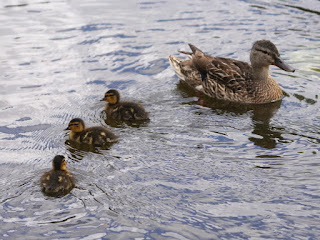So far there has been no conflict with the pair with the single cygnet. Mother and cygnet were peacefully touting for food at the Vista.
The Black Swan's new wing feathers are almost fully grown, and it will be airworthy again soon.
The five Egyptian teenagers on the Serpentine were stretching their big new wings, preparing for their first attempts at flying.
They still like to sit in a companionable huddle as they did when they were little chicks.
A Mallard at Peter Pan had three ducklings.
A remarkable picture from Battersea Park by Joan Chatterley: a partly leucistic Mallard drake. I don't think it's the offspring of a white duck and a normal one, as these tend to have large patches of colour. It's probably going into eclipse, and may look quite different when it regrows its breeding plumage in the autumn.
The Great Crested Grebes' nest at the west end of the island is still attached to the wire basket, but it's a crazy ramshackle construction even by grebe standards.
A Moorhen worked over the Coots' nest under the marble fountain, looking for bugs. The nest was abandoned when a Grey Heron started using it as a fishing platform.
A heron crossed the small waterfall in the Dell. This is the heron that took over from the injured one, which I haven't seen for several weeks and seems to have died -- sad, because it was hatched here and had already been rescued once, so we had a personal interest in it.
A fine backlit picture by Virginia of a heron preening on a post.
Two Carrion Crows sat on an ants' nest and bathed in ants to get rid of their parasites. More crows waited their turn. The two anting crows must be quite senior, or they would have been pushed out.
A holly tree beside the Long Water is a meeting place for Starlings, and has been for a long time. It's not clear why they chose this tree, though the spiky evergreen leaves do provide year-round cover from predators.
A Wren struck a grand pose on a twig beside the Long Water.
I think this hoverfly is a Tapered Dronefly, Eristalis pertinax. Composite flowers like this big daisy in the Rose Garden keep insects busy as each floret has to be attended to, which makes it easy to get a photograph.
The peculiar Harlequin Glorybower bush had a Harlequin Ladybird on it.














That's a native ladybird species, right? Sometimes I daydram that I buy me some and start my own ladybug farm, but before I'd need to have good potted plants for them to live in.
ReplyDeletePoor unfortunate heron. I hope it will be happy in the heaven of birds as it couldn't be on this earth.
No, sadly. Harlequin Ladybirds are an alien species stupidly introduced from Asia to fight aphids and now spreading uncontrollably and wiping out native species.
DeleteI've seen relatively few Harlequins this year, whereas we have very large numbers of 7-spots this year. It appears a number of parasitoids seem to be now targeting Harlequins so there does seem to be a control mechanism in place. Of course it would have been better if they hadn't arrived but are here for the long term now.
ReplyDeleteNice photo of the Eristalis hoverfly.
Unusual Mallard- I think it's derived from one of the domestic breeds.
I haven't seen anything but Harlequins in the park for some time. But the giant infestations seen a few years ago seem to be over.
Delete